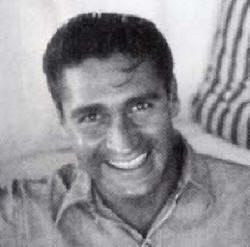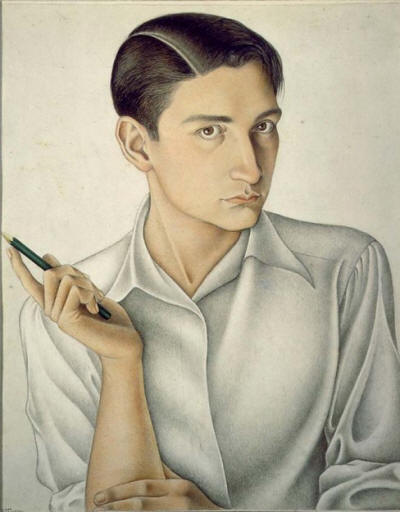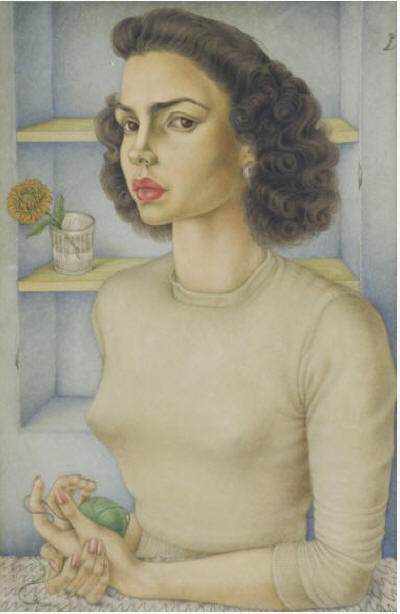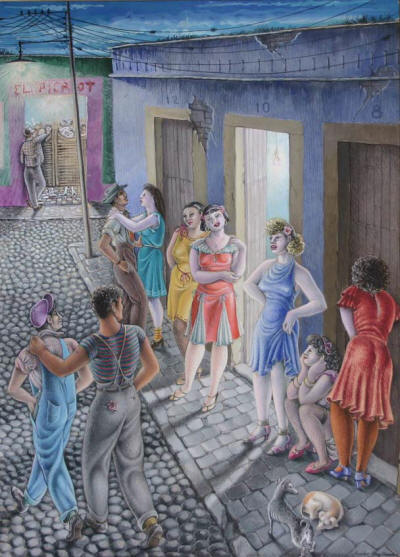

 Emilio Baz Viaud (1918-1991) was a Mexican painter. He entered the Academy of San Carlos
at 20 years old. Whatever precocious talent he may have had as a child, it was apparently refined while watching his older gay brother
Ben-Hur Baz Viaud at work on his own precisionist drawings. Ben-Hur, twelve years his senior, had also studied at the Academy before moving to New York in 1926, where he established himself as a successful commercial illustrator.
Emilio Baz Viaud (1918-1991) was a Mexican painter. He entered the Academy of San Carlos
at 20 years old. Whatever precocious talent he may have had as a child, it was apparently refined while watching his older gay brother
Ben-Hur Baz Viaud at work on his own precisionist drawings. Ben-Hur, twelve years his senior, had also studied at the Academy before moving to New York in 1926, where he established himself as a successful commercial illustrator.
Born in Mexico City, Emilio first studied architecture. He was later taught painting by Manuel Rodríguez Lozano, a mentor who was also an openly homosexual artist. Emilio did not have his first exhibition until 1951, although his works were displayed alongside such eminent artists as Siqueiros and Diego Rivera.
In Emilio’s 1935 self portrait he wears a white shirt so simple that the buttons remain concealed; his hair is meticulously creamed and combed, and his young skin flawless. He holds a green pencil in his right hand and grips his elbow with the left, forming a stiff right angle that locks the lower half of the composition in place. The young artist strives for absolute elegance, perhaps hoping to prove a sense of sophistication beyond his years.

Self-Portrait (1935)
Watercolor and dry brush on cardboard, 36" x 24"


Emilio Baz Viaud (Mexican 1918-1991)
Retrato de Silvia
signed and dated 'E. Baz Viaud 1943' (lower right)
watercolor and pencil on paper
38¼ x 25¼ in. (97.1 x 64.1 cm.)
Executed in 1943.

Emilio Baz Viaud
Mexican, 1918-1991
Painter George Hutzler, Age 28, with His Pet Bimba, 1949
Signed Emilio Baz Viaud and inscribed Portrait of the painter/George Hutzler,/aged 28, with his/pet Bimba, don it/San Miguel de Allende,/Mexico,/in the month of/April, 1949,/by his friend (ul)
Pencil and tempera on Glarco watercolor board
30 x 22 inches (76.2 x 55.88 cm)

Portrait of Margot Mac Inteyre

His-majesty-R22

Portrait-of-Nazario-Chimez-Barket

Emilio Baz Viaud
La calle de Cuauhtemotzin, 1941
Temple y pincel seco / cartulina
51 x 37 cm
EBV013
By comparison, the later self portrait casts aside delicacy, portraying a man with hyper-masculine, movie star good looks – bronzed and healthy. With pencil in hand and an almost hidden sheet of paper under his left elbow, Emilio is seated in front of his work table, ready to begin. Proportions and perspective are deliberately distorted, lending a slight surrealistic accent to the portrait.
These two self portraits, dated just six years apart, provide a telling window into the artist’s psyche. Unfortunately, Emilio Baz Viaud was little known, even in his native Mexico. It was not until late in his life that his work was reassessed and appreciated by a larger audience.
Influenced by the Magic Realism movement, Emilio’s meticulous technique of applying oil paint to dry surfaces was praised by colleagues and critics, who unanimously compared his work to Renaissance artists such as Dürer and Boticelli.
For a short time in the 1970s Emilio Baz Viaud dabbled in abstract painting, but his legacy comes from his work realized prior to 1955, especially his portraits.
My published books: